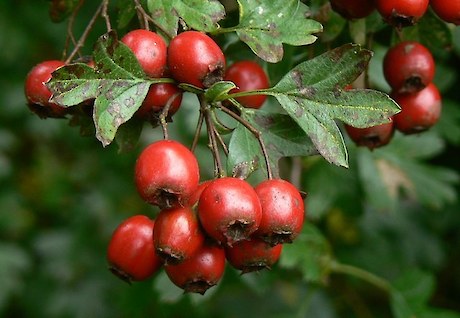Crataegus laevigata/monogyna
Download info sheetFamily
Rosaceae
Common name
Haw, Maythorn, Hedgethorn
Description
Deciduous small tree growing to 5-6 metres, densely branched and spiny, with lobed obvate leaves. Scented white flowers appear in late Spring, followed by dark red, eggshaped fruits. (Bown, 1995, p 112).
Habitat
Occurs throughout northern temperate regions, including Europe and China. Used as a hedgerow in New Zealand farm settlements.
Cultivation
Likes a sunny position. Can be propagated by seed gathered when ripe and stratified for 18 months before sowing in early Spring. Can be prone to leafspot, rust, powdery mildew. Berries are picked when ripe in Autumn.
Historical
Many historical practices are associated with Hawthorn eg. going ‘a Maying’ and choosing a “May Queen”. It has long medicinal use as a circulatory and digestive tonic.
Culinary
Hawthorn Jelly is a traditional recipe for a clear jelly/jam made from the haws – the wild hawthorn berries.
Medicinal
The leaves, flowering tops and fruit (berries) are used medicinally in modern herbal medicine.
Hawthorn has been shown to improve heart blood flow and lower blood lipid levels. It also has an anti-inflammatory action. It may also be liver protective. Research has shown it particularly useful in treatment of congestive heart failure. It also has an anti-viral action – against herpes simplex (cold sore) virus. Dosage range : infusion of dried herb – up to 2g three times a day. (Braun and Cohen, p412 – 415.)
Constituents
Leaves and flowers contain approximately 1% flavonoids such as rutin and quercitin and 1-3% oligomeric procyanidins. Also contains Vitamin C (40-60mg/100mg of berries), carotene (5mg/100mg berries) and other vitamins and minerals.
Contraindications/cautions
Care when harvesting as thorns are long and sharp – wear gloves and protect your arms.
Hawthorn may help lower blood pressure therefore use with caution when taking antihypertensive pharmaceuticals.
References:
Bown, D. ( 1995 ) Encyclopedia of Herbs and their Uses. Dorling Kindersley. NSW. Australia.
Chevallier, A. (1996) The Encyclopedia of Medicinal Plants. Dorling Kindersley, London.
Braun, L and Cohen, M. (2007). Herbs and Natural Supplements. An evidence-based guide. 2nd Edition. Churchill Livingstone. Sydney, Australia.

